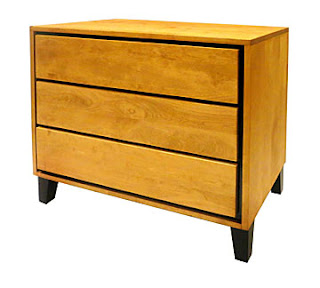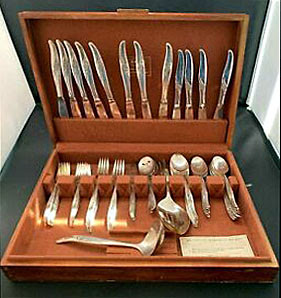 QUESTION: For the last several years I’ve begun to purchase various pieces of Mid-Century Modern furniture and accessories. While doing so, the name Russel Wright has come up frequently. I understand he was one of the more influential industrial designers of the 20th century. I’d like to learn more about him and his designs, so that I can be on the lookout for them as I browse thrift shops and used furniture stores. What can you tell me about Wright and his designs?
QUESTION: For the last several years I’ve begun to purchase various pieces of Mid-Century Modern furniture and accessories. While doing so, the name Russel Wright has come up frequently. I understand he was one of the more influential industrial designers of the 20th century. I’d like to learn more about him and his designs, so that I can be on the lookout for them as I browse thrift shops and used furniture stores. What can you tell me about Wright and his designs?
ANSWER: Russel Wright was indeed a master of modern design. He created dinnerware, glasses, spun aluminum, wooden tableware, stainless steel flatware, textiles, and furniture, giving a sense of style to the modern American home. Wright was one of the premier industrial designers of the modern era.
 He first began to work in silver and chrome, creating small decorative circus animals for gift shops. His later work in chrome came after he signed a contract to design for Chase Brass & Copper, which he did from 1935 to 1946. Wright's designs for Chase are hot marked with his name.
He first began to work in silver and chrome, creating small decorative circus animals for gift shops. His later work in chrome came after he signed a contract to design for Chase Brass & Copper, which he did from 1935 to 1946. Wright's designs for Chase are hot marked with his name.
Wright’s early gift items were expensive, and being in the midst of the Great Depression, he found it necessary to develop items that were more affordable. So he instead turned to spun aluminum, actually manufacturing items in the basement of he and his wife’s home. He created around a 100 items, including stove-to-table items, a concept which doesn’t work well in aluminum but which was later expressed in other materials. Wright combined aluminum with wood, rattan, or cork, enabling the resulting pieces to be combined in a variety of ways.
From aluminum Wright moved on in 1935 to create the Oceanic line of woodenware for Elise Wood Working Company. For these designs, he used naturalistic the forms of leaves, snail spirals, starfish, and water ripples. Even though they were all machine made, these products had a handmade look and feel.
 Wright's first furniture designs, for Heywood-Wakefield in 1934, made use of curved veneers and looked more Art Deco than his later furniture. Unfortunately, these pieces didn’t sell well and weren’t durable enough to use constantly. But they showed Wright's early interest in open stock pieces that could be used in a variety of ways.
Wright's first furniture designs, for Heywood-Wakefield in 1934, made use of curved veneers and looked more Art Deco than his later furniture. Unfortunately, these pieces didn’t sell well and weren’t durable enough to use constantly. But they showed Wright's early interest in open stock pieces that could be used in a variety of ways.
 The breakthrough in furniture design for Wright came with his introduction of American Modern, a line manufactured in American rock maple by Conant Ball, which sold the pieces in both dark and "blonde" finishes. Wright’s wife, Mary, coined the name "American Modern," which was later used for other products for the home. Macy's was so enthusiastic about the furniture line that they constructed a nine-room house in their New York store to display the furniture in room settings.
The breakthrough in furniture design for Wright came with his introduction of American Modern, a line manufactured in American rock maple by Conant Ball, which sold the pieces in both dark and "blonde" finishes. Wright’s wife, Mary, coined the name "American Modern," which was later used for other products for the home. Macy's was so enthusiastic about the furniture line that they constructed a nine-room house in their New York store to display the furniture in room settings.
 Wright also worked with the Old Hickory Furniture Company in Martinsville, Indiana on unique rustic furniture featuring his modern stylings. The Old Hickory line first appeared in 1942 and some of the designs stayed popular through the 1950s.
Wright also worked with the Old Hickory Furniture Company in Martinsville, Indiana on unique rustic furniture featuring his modern stylings. The Old Hickory line first appeared in 1942 and some of the designs stayed popular through the 1950s.
In 1939, Wright introduced a colorful line of American Modern china, the most widely sold American ceramic dinnerware in the country’s history, made by Steubenville Pottery, of Steubenville, Ohio. But American Modem china was low-tired, thus subject to chipping and crazing. After World War II, Wright introduced Iroquois Casual China, made with a high-fired glaze, suitable for dishwasher use, that came with a three-year guarantee.
 He followed his successful china line with glasses, flatware and textiles. This was the beginning of Wright’s American lifestyle, as he offered consumers a way to create a comfortable home with a unified look as they put it together, piece by piece. American Modern china, in production from 1939 until 1959, was the country’s all-time biggest selling line of dishes.
He followed his successful china line with glasses, flatware and textiles. This was the beginning of Wright’s American lifestyle, as he offered consumers a way to create a comfortable home with a unified look as they put it together, piece by piece. American Modern china, in production from 1939 until 1959, was the country’s all-time biggest selling line of dishes.
In addition to ceramic dinnerware, Wright also designed several popular lines of Melmac melamine resin plastic dinnerware for the home and did early research on plastic Melmac dinnerware for restaurant use. Beginning in 1953, Northern Plastic Company of Boston began production of his first Melmac line of plastic dinnerware for the home, called "Residential."
As with his ceramic dinnerware, Wright began designing his Melmac only in solid colors, but by the end of the 1950s created several patterns ornamented with decoration, usually depicting plant forms.
Wright's approach to design came from the belief that the dining table was the center of the home. Working outward from there, he designed tableware to larger furniture, architecture to landscaping, all fostering an easy, informal lifestyle. It was through his popular and widely distributed housewares and furnishings that he influenced the way many Americans lived and organized their homes in the mid-20th century.
To read more articles on antiques, please visit the Antiques Articles section of my Web site. And to stay up to the minute on antiques and collectibles, please join the over 30,000 readers by following my free online magazine, #TheAntiquesAlmanac. Learn more about "Coffee--The Brew of Life" in the 2023 Summer Edition, online now. And to read daily posts about unique objects from the past and their histories, like the #Antiques and More Collection on Facebook.




















